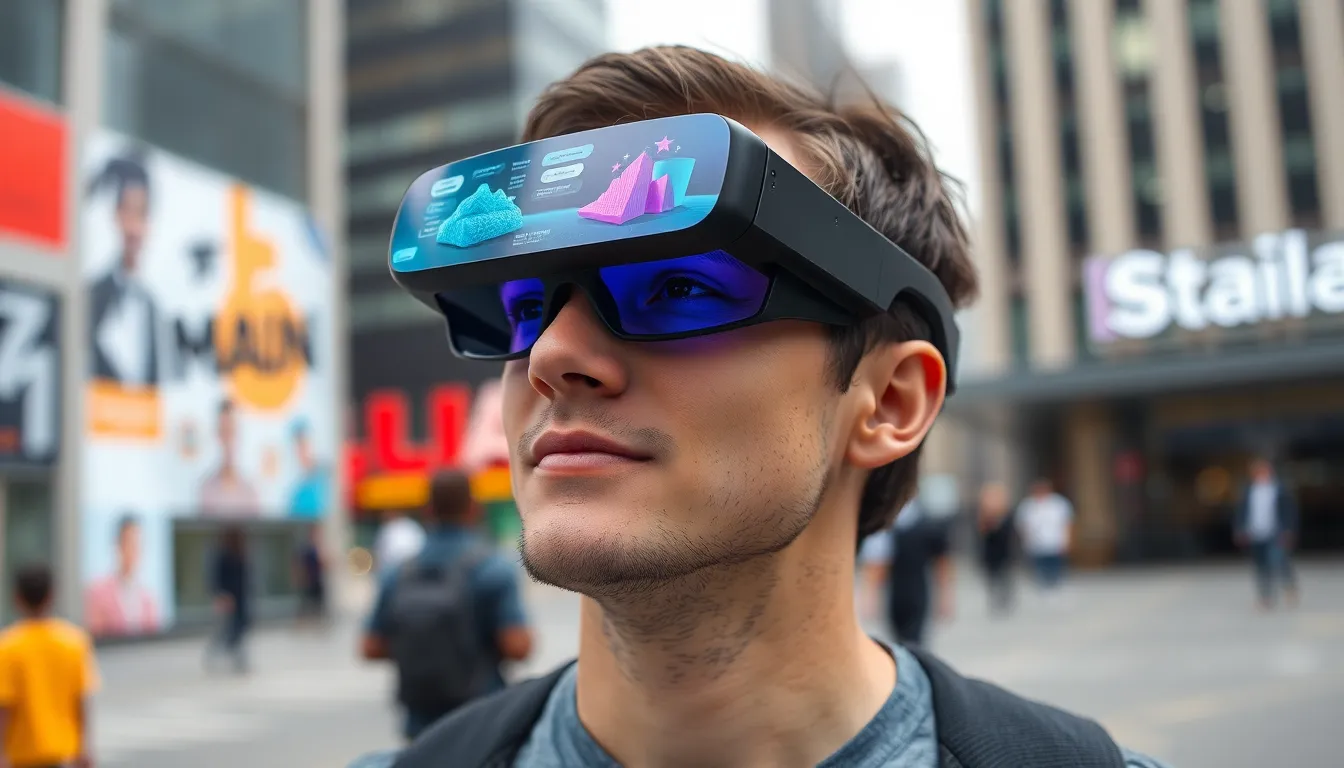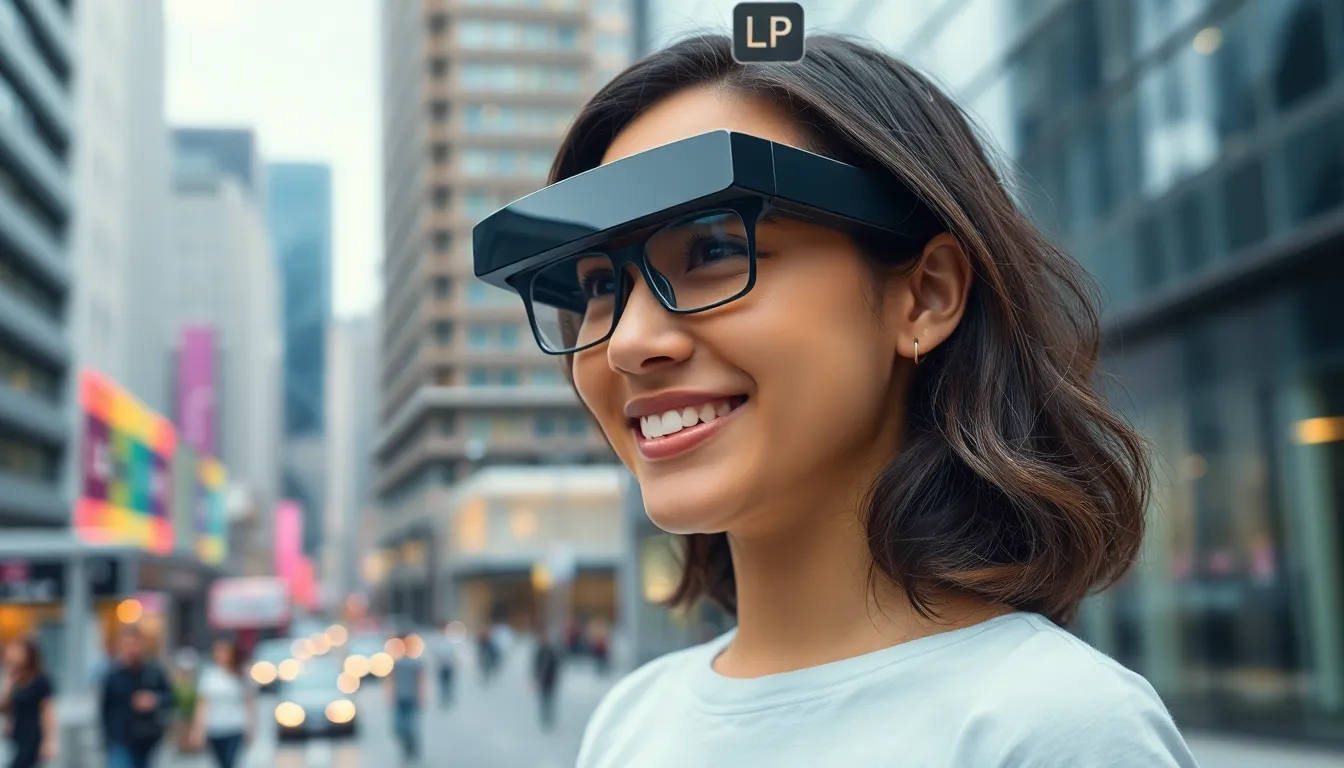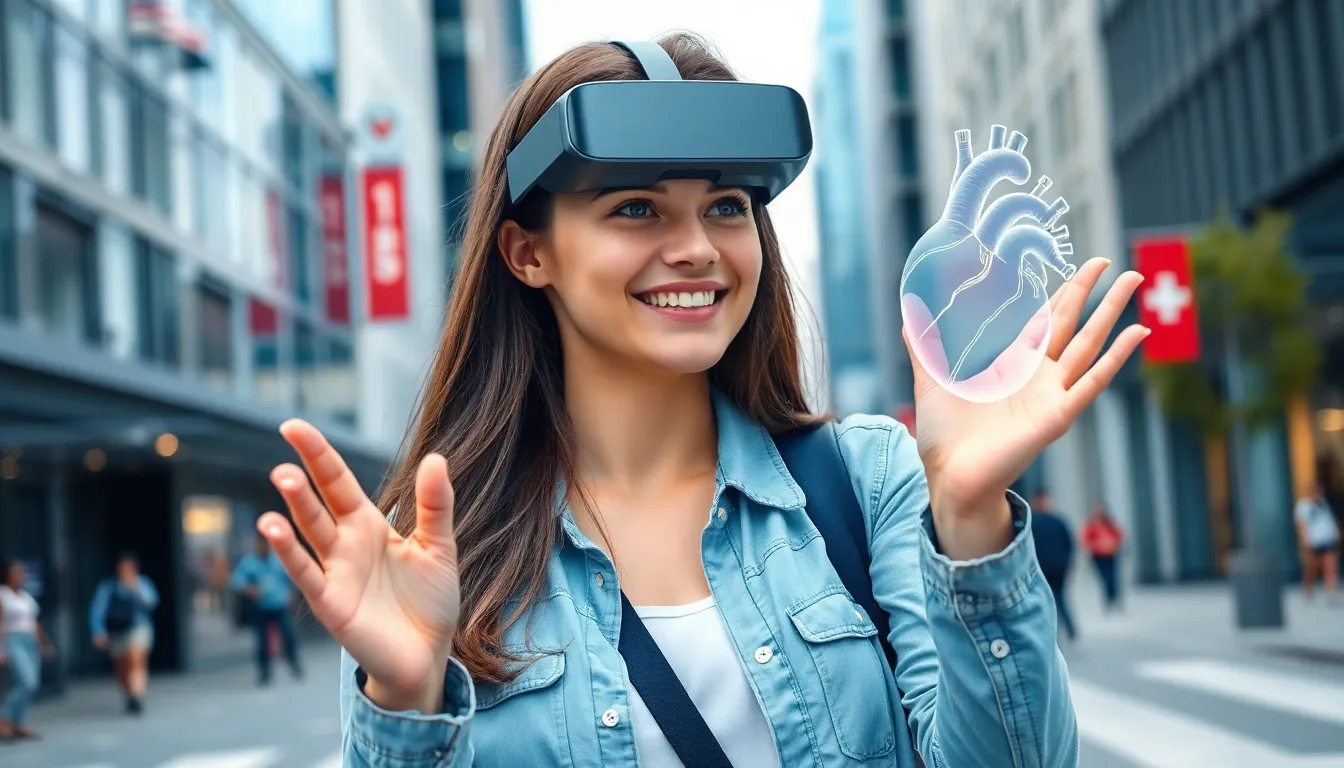Augmented reality glasses are revolutionizing the way people interact with the world around them. By overlaying digital information onto the real environment, these innovative devices enhance everyday experiences, from gaming to education and beyond. As technology advances, the potential applications seem limitless, sparking excitement and curiosity among consumers and developers alike.
With leading tech companies racing to bring their own versions to market, augmented reality glasses are poised to become a staple in modern life. They promise not just to change how users see their surroundings but also to redefine how they engage with information and each other. As this technology continues to evolve, it’s essential to explore what these glasses can do and how they might shape the future of communication and interaction.
Table of Contents
ToggleOverview of Augmented Reality Glasses
Augmented reality glasses superimpose digital information onto the real world, merging virtual elements with physical environments. These devices utilize technologies like computer vision, simultaneous localization and mapping (SLAM), and depth tracking to create immersive experiences.
Key Features of Augmented Reality Glasses
- Display Technology: AR glasses employ microdisplays or projection mechanisms to present visual data. Varied display types include OLED and LCD options.
- Sensors: AR glasses integrate multiple sensors such as accelerometers, gyroscopes, and cameras. These sensors track user movements and environmental changes to enhance interaction.
- Connectivity: Most models connect to smartphones or other devices via Bluetooth or Wi-Fi. This connectivity allows for real-time data syncing and richer content access.
- Interactivity: Many AR glasses feature touchpads or voice recognition. Users can interact with virtual elements through gestures or commands, facilitating intuitive navigation.
Applications of Augmented Reality Glasses
- Gaming: AR glasses revolutionize the gaming landscape by providing immersive gameplay. Users experience games that merge digital characters and scenarios with their physical surroundings.
- Education: In education, AR glasses offer unique learning experiences. Students can visualize complex concepts and engage in interactive lessons, enhancing retention and understanding.
- Navigation: AR glasses assist in navigation by overlaying directions onto the real world. This feature helps users find routes without diverting their attention from their environment.
- Healthcare: In the healthcare sector, medical professionals utilize AR glasses for surgery and diagnostics. These devices provide critical information during procedures, improving accuracy and efficiency.
By understanding the capabilities of augmented reality glasses, users gain insight into how these devices can enrich communication and enhance interaction with their surroundings.
Key Features of Augmented Reality Glasses

Augmented reality glasses boast several advanced features that enhance user experiences across various applications. These features contribute to the effectiveness and versatility of AR technology.
Display Technology
Display technology in AR glasses includes high-resolution screens such as OLED or LCD. OLED displays deliver vibrant colors and superior contrast, enabling better visibility in diverse lighting conditions. Various AR glasses utilize light guide technology or microprojectors to overlay digital images seamlessly onto the user’s field of view. This innovation ensures that digital content appears realistic and interactive within the physical environment.
Audio Capabilities
Audio capabilities are crucial for creating immersive experiences in AR. Many AR glasses integrate directional audio systems that produce 3D soundscapes, allowing users to perceive spatial audio cues relative to their environment. Built-in microphones often enable voice recognition, facilitating hands-free control and commands. This feature enhances user engagement, particularly in gaming and navigation applications.
User Interface
User interfaces in AR glasses prioritize intuitive interaction. Options include touchpads, gesture controls, and voice commands, allowing users to engage with applications effortlessly. Customizable interfaces provide personalized experiences, enabling users to arrange content according to their preferences. Many AR glasses recognize eye movements, using this data to enhance navigation and selection efficiency within digital overlays.
Popular Augmented Reality Glasses on the Market
Several leading augmented reality (AR) glasses on the market showcase innovative features and capabilities. These products cater to various applications, enhancing both professional and recreational experiences.
Product A
Microsoft HoloLens 2 offers a comprehensive mixed reality experience. The device features a high-resolution display with 2K resolution per eye, ensuring clarity in digital overlays. Advanced hand tracking and eye tracking functionalities facilitate intuitive navigation. With built-in spatial audio technology, users enjoy immersive sound experiences. HoloLens 2 finds applications in enterprise solutions, including training and remote assistance, demonstrating its potential to improve productivity.
Product B
Google Glass Enterprise Edition 2 targets business needs with practical features. The lightweight design weighs just 50 grams, promoting comfort during prolonged use. It supports hands-free operation through voice commands and includes a 720p HD camera for capturing images and videos. Google Glass enhances workplace efficiency in industries like manufacturing and logistics by providing real-time information and enabling task documentation.
Product C
Snap Spectacles 3 focuses on social experiences, integrating AR with casual user interactions. These glasses feature dual 3D cameras for capturing depth and creating AR effects. Users can easily apply filters and 3D effects to their photos and videos, enhancing social media sharing. Spectacles 3 are designed for content creators and social media enthusiasts, showcasing how AR can enrich everyday moments through creativity and interaction.
Applications of Augmented Reality Glasses
Augmented reality glasses find applications across various fields, enhancing experiences through immersive digital overlays. Key sectors include gaming, education, training, and healthcare.
Gaming and Entertainment
Gaming experiences with AR glasses offer immersive environments, blending physical and virtual elements. Users engage in interactive narratives and challenges where digital characters and objects coexist. Popular titles like Pokémon GO demonstrate real-world integration, prompting exploration and social interaction. Companies design games with advanced graphics and real-time data, ensuring engagement through competitive play and rich storytelling. Additionally, AR glasses enable multiplayer experiences, allowing players to interact regardless of their physical locations.
Education and Training
Education benefits from AR glasses by transforming traditional learning methods. Teachers incorporate interactive lessons, allowing students to visualize complex concepts. For example, anatomy students can study 3D models of the human body, developing a deeper understanding. Training programs in industries such as aviation and manufacturing utilize AR glasses to provide simulations and hands-on experiences, improving skill acquisition and retention. Companies implement AR solutions to enhance employee onboarding, offering real-time guidance and support during training tasks.
Healthcare
Healthcare professionals utilize AR glasses to enhance patient care and surgical precision. Surgeons employ AR technology for overlaying critical data during procedures, improving outcomes and minimizing errors. Medical education benefits from visualizing anatomical structures and biological processes, aiding in comprehensive learning. Additionally, AR glasses facilitate remote consultations, allowing specialists to provide guidance in real-time. These innovations significantly improve communication, efficiency, and effectiveness in healthcare delivery.
Challenges and Future of Augmented Reality Glasses
Augmented reality glasses face several challenges that impact their widespread adoption. Limited battery life poses a significant hurdle, restricting usage time during critical tasks. Average battery performance lasts around two to three hours, making continuous use impractical in many situations. High manufacturing costs also contribute to limited accessibility, with high-end models exceeding $2,000. This cost creates barriers for potential consumers and businesses alike.
User acceptance presents another challenge. Initial discomfort from wearing AR glasses, such as weight and fit issues, detracts from the overall experience. Social perceptions of wearing such devices can also lead to hesitation, as individuals may feel self-conscious in public settings while using AR technology. Data privacy concerns arise with the collection of user information through integrated cameras and sensors. Maintaining user trust remains vital.
Despite these challenges, the future of augmented reality glasses exhibits significant potential for growth. Advancements in battery technology may extend usage time, with research into new materials and energy sources underway. Improved manufacturing processes aim to lower production costs, making AR glasses more affordable.
Enhanced user interface designs will likely increase comfort and usability, encouraging broader acceptance. Innovations in ergonomics and lightweight materials can lead to more appealing options for consumers. Continued exploration of applications in varied fields, including telemedicine, remote collaboration, and manufacturing, promises to showcase the versatility of AR glasses.
Major tech companies are investing in the development of AR ecosystems that complement glasses with compatible applications. Collaborative efforts between software and hardware developers will drive enhanced functionality, providing seamless integration between physical and digital environments. As AR technology matures, the possibility of widespread adoption becomes increasingly realistic. The combination of addressing current challenges and embracing future innovations creates an optimistic outlook for augmented reality glasses.
Augmented reality glasses are set to redefine how people experience the world around them. With their ability to blend digital information seamlessly into everyday life, these devices promise to enhance various sectors from gaming to healthcare. As technology continues to evolve, improvements in battery life, comfort, and affordability will likely drive broader acceptance among users.
The competitive landscape among tech giants ensures ongoing innovation, paving the way for more advanced applications and features. Ultimately, AR glasses hold the potential to transform interactions and communication, making them an essential tool for the future. Embracing this technology could unlock new possibilities and reshape the way individuals engage with their environments.






